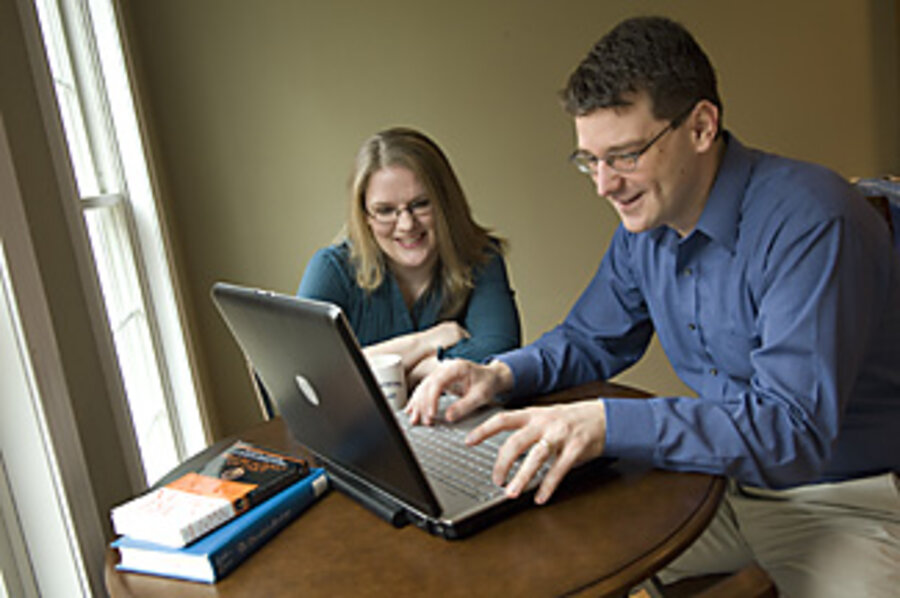Do politics really tilt classrooms?
For April Kelly-Woessner and her husband, Matthew Woessner, political issues don't break neatly into "red" and "blue" in everyday conversation.
Both of them are political scientists. And they're registered in different parties.
But the Woessners, who each teach at the college level in Pennsylvania, say they're better at their jobs because of that dynamic. And together they're working on pioneering research that explores the question: How do students' and professors' politics affect the classroom?
It's an area ripe for facts. Too often, the research duo says, conservatives rely on exaggerated anecdotes to paint campuses as chock-full of liberal bias, while liberals are dismissive of what might be legitimate concerns. Their studies aren't meant to provide ammunition for one side or the other. Instead, they hope to remove the cloud of rhetoric and to inform the debate – and the academic climate – with data.
Colleges should prepare students for the political side of citizenship, but "we need to really be careful that there's a serious commitment by everybody to open-mindedness," says Anne Colby, co-author of "Educating for Democracy" and a senior scholar at the Carnegie Foundation for the Advancement of Teaching in Stanford, Calif. As professors attempt various strategies to do that, it's useful "to understand it from the students' point of view ... and I don't think anyone else has done that," she says of the Woessners' research.
Political leanings do make a difference, but sometimes in subtle ways, the researchers found. Students feel less comfortable and give their professors lower ratings if they believe them to hold political views different from their own. But variables, such as the professor's level of caring and objectivity, can moderate the situation.
Mr. Woessner teaches at Penn State Harrisburg, and Ms. Kelly-Woessner at Elizabethtown College. After the 9/11 attacks, "the classroom environment became very politicized," she says. In discussions about war and antiterrorism measures, "you saw students really taking sides ... and you had to wonder to what extent your views on that were influencing your class."
She polled her students to make sure it wasn't obvious whether she was a Republican or Democrat (she's the latter). Her husband also took care to present various sides in class, but outside class, he dropped a policy of keeping his conservative views quiet. With so much liberal opposition being voiced on campus in advance of the Iraq war, he says, "being the political minority, I had a certain responsibility to be visible."
To get beyond their own experience, they surveyed the students of 30 professors around the United States. In nearly 1,400 responses, students rated their professors and themselves on ideological and partisan scales. They also addressed how much they liked the course and the professor and how much they learned.
"This is probably empirically one of the best studies I've seen on this topic," says John Ishiyama, editor in chief of the Journal of Political Science Education, which will be publishing the Woessners' most recent peer-reviewed article in September.
Students who saw their professor as having a similar political disposition to their own reported that they learned more. But several explanations for that are possible. It could be that students who disagree with their professor's views follow a natural tendency to avoid or discredit information in the class. "But it's also possible," Kelly-Woessner says, "that rather than affecting real learning, you're merely affecting students' confidence in their learning." Those who are frequently challenged may learn a lot but lose confidence in the process.
That's important, she says, because "people who are confident that they understand politics are much more likely to participate." Professors commonly play "devil's advocate" to push students to back up their arguments, and debates make for lively classes, but this suggests the need to take care that some students don't shut down in response.
No correlation was found between students' partisan difference with professors and their sense of being graded fairly. "That was very striking ... [because] one of the arguments about liberal faculty has been that somehow they're punishing conservative students," Mr. Ishiyama says.
Professors, on the other hand, may have cause for concern if their prospects for tenure are tied strongly to student evaluations. The greater the ideological or partisan differences that students perceive with their professor, the lower their evaluation of him or her. Students aren't always objective, so "if students say, 'I feel like the professor was biased,' you can't really take that at face value," says Ms. Colby of the Carnegie Foundation.
The Woessners' next study will measure how students' ideological views change over time and how that relates to professors' actual ideological and partisan affiliations.
Meanwhile, they draw on their practice debating each other respectfully as they strive to be good role models for students. The two met in graduate school in 1996 and married four years later. "When Matthew and I disagreed, instead of taking offense, we took interest," Kelly-Woessner says.
They've both moderated their views over time. "April has an instinct to challenge my first assumptions," Woessner says. She'll point out bias on Fox News that goes right past him, and he'll do the same when they're watching MSNBC.





